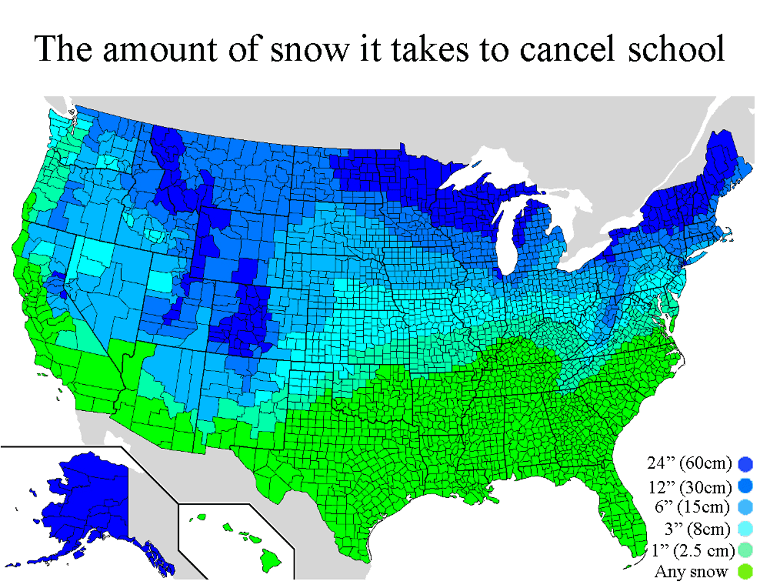The map of school closures due to snowfall paints a telling picture of regional readiness and resilience. It’s a stark reminder of the varying capabilities and approaches to winter weather across the United States. In the South, a mere whisper of snow can lead to widespread school closures, while in the North and Midwest, life goes on despite several inches—or even feet—of snow.

A Tale of Two Climates
In the warmer Southern states, snow is a rare guest, and as such, the infrastructure and public services are not geared up for significant snowfall. The result? Schools and businesses close at the first sign of snow. This cautious approach often draws chuckles from their Northern neighbors, where snowplows and salt trucks are a regular part of winter life.
The Southern Snow Paradox
Interestingly, New Mexico, with its varied elevation and climate zones, doesn’t always conform to the Southern shutdown trend. Despite having areas that receive regular snowfall, the state doesn’t always call for school closures, suggesting a more nuanced approach to winter weather.
Tennessee’s Snow Tolerance
Tennessee presents another curious case. Despite its Southern location, one might expect a certain level of snow tolerance. However, the state often opts for caution, closing schools with relatively low snowfall, much like its Southern counterparts.
The Equipment Equation
The frequency of snowfall directly impacts a region’s investment in snow removal equipment and resources. In the South, where heavy snow is a rarity, it’s economically impractical to maintain a large fleet of snowplows. This lack of equipment is a key factor in the decision to close schools when snow is forecasted.
Weathering the Storm: School Closures and Snowfall Across America
The fascinating dynamics of school closures due to snowfall across the United States reveal much about regional preparedness and the cultural responses to winter’s challenges. The contrast is especially stark between the snow-hardened states of the North and Midwest and the more snow-averse South.
The Southern Snow Shutdown
In the South, the rarity of snowfall means that even a light dusting can lead to preemptive school closures. This cautious stance may seem excessive to some, but without the proper winter weather resources, Southern cities are often looking to avoid the risks associated with even minor snow events.
The Northern Grit
Conversely, Northern and Midwestern states are well-equipped and accustomed to dealing with heavy snow. Schools in these regions often remain open in conditions that would certainly close those further south. It’s a testament to their winter readiness and resilience.
The Economic Impact of Snow
The decision to close schools isn’t taken lightly and often comes down to economics. Maintaining a fleet of snow-clearing equipment can be costly, and in regions where snow is infrequent, such as the South, it’s not always feasible. This economic consideration plays a significant role in how different regions respond to snowfall, as detailed in discussions on regional economic decisions.
Adapting to the Unexpected
Even within the South, there are anomalies. New Mexico, for example, has areas well-versed in handling snow, while others are not. This variation within a single state underscores the complexity of weather adaptation strategies.
The Broader Implications
The map of snow-induced school closures isn’t just about whether children get a day off; it’s indicative of a region’s infrastructure and its ability to handle unexpected weather events. For more in-depth analysis on how different areas manage and what it means for public policy, visit LegalKnowItAll’s feature on infrastructure and public safety.
The snow day policies across the US are more than a matter of convenience; they reflect deeper issues of preparedness, economic priorities, and safety. The South’s approach to snow days, while often mocked by their Northern counterparts, is a rational response to their unique circumstances. For a deeper dive into the legal and societal implications of these regional differences, explore the insights at LegalKnowItAll.
The map of snow-induced school closures tells a story of regional adaptation—or the lack thereof—to winter weather. It highlights the cultural and practical differences in how Americans deal with snow. The moral of the story? When it comes to snow, the South plays it safe, while the North and Midwest brace and endure, keeping schools open against a wintry backdrop that would bring other regions to a standstill.
As an Amazon Associate we earn from qualifying purchases through some links in our articles.
